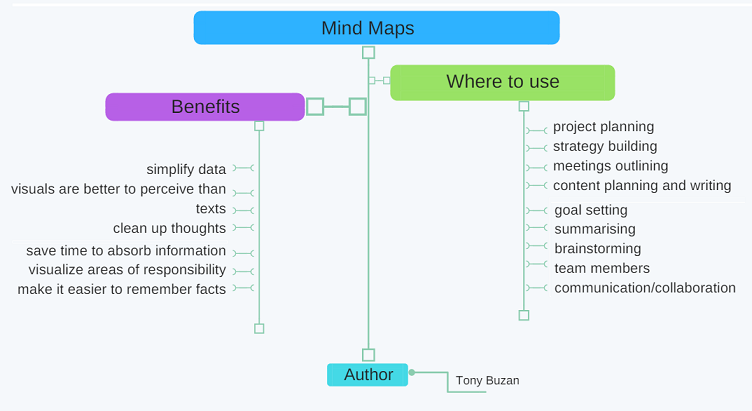A look at 15 best and (almost) free mind mapping tools for nonprofits

Let’s imagine a tree, a spider, or an octopus. Or anything else with a center (read: core idea or problem) and shoots (related points to consider for that idea realization or problem solving). Each branch, tarsus, or arm has its own, smaller offshoots, also crucial for the whole organism to work.
The same principle lies at the heart of a mind map. It’s a visual representation of keynote thoughts centered around the main idea. Mind maps help us stay organized in the world of content shock, informational chaos, and short attention span.
Psychologists revealed the power of this instrument for the human brain a long time ago. They say mind mapping makes people more creative and retentive.
That’s all well and fine, but what about its use in practice for your nonprofit organization?
Why use mind maps in your nonprofit practice?
Mind mapping is an exceptional tool for business planning, communicating ideas to employees, and supporting your nonprofit organization’s project management processes. It improves collaboration between teams: according to the research by mind mapping expert Chuck Frey, employees who use maps are 30 percent more productive.

Mind maps can help you:
- Plan nonprofit projects. Create a mind map, specifying a goal to reach or a problem to solve, share it with team members, and edit it accordingly to control tasks and project processes.
- Prepare and conduct business meetings. Use a mind map to outline your speech, keep a logical narrative, and sum up everything. Mind mapping tools allow you to visualize all points.
- Build business strategies, analyze all the research in your nonprofit niche, and summarize everything.
- Brainstorm ideas for innovative solutions for your projects.
How to create mind maps
Developed by British psychologist Tony Buzan, you create a mind map creation by:
- Starting with a central idea and following the thought hierarchy.
- Representing a single idea with one or two words, colors, or images.
- Categorizing ideas by using different visual elements.
- Connecting subsidiary ideas around a central one with lines. Link all branches, so they lead to a core idea.
- Leaving some space between blocks to make each branch clearer.
- Making blocks, lines, images extensive for better thesis statements, arguments, perception, and conclusions.
- Staying clear and concise. Implement unified hierarchy styles through your mind map to organize ideas.
All you need to draw a mind map and focus on business ideas and nonprofit project processes are a whiteboard and colored markers. Some managers also like to use Microsoft Paint or PowerPoint or Keynote for mind mapping. There are also tools and software (both desktop and mobile) specifically designed to help you organize work and enhance staff and volunteer productivity.
15 best mind mapping tools to use at nonprofit organizations
- Mind Meister. This web-based mind mapping tool doesn’t require downloads or updates. You create an account (or sign up with Google or Facebook), then use Mind Meister to brainstorm or plan your nonprofit projects. Whether you use Windows, Linux, or Mac OS, you can access the tool inside your browser. You can also share maps with colleagues so they can elaborate on them if needed. Free, with advanced options available for a fee.
- Miro. This online collaborative whiteboard platform is perfect for teamwork. With Miro, you can run online remote meetings, co-create projects, develop ideas, explain processes to your volunteers, and more. The instrument comes with ready-made templates for even more efficient team collaboration. Free, with advanced options available for a fee.
- MindMup. Perfect for mind mapping newbies, the tool offers an intuitive interface and features. You can add and edit images and texts with two clicks and create or delete branches with a single click. MindMup is great for planning, note-taking, and teamwork. Free, with advanced options available for a fee.
- Mind42. This tool allows you to create to-do lists, organize business events, brainstorm ideas for new projects, and more. Use it to collaborate with co-workers, assign tasks, and see mind maps created by others. Free.
- SmartDraw. This one is software for linear mind mapping. It includes more than 70 templates of diagrams and flowcharts, with automatic formatting for faster and easier work. Perfect for individual use, but you can also add a team of five or more users for an extra fee. Purchase required.
- MindManager. Create mind maps by categories (meetings, events, strategy planning, personal productivity, problem solving) and prioritize tasks. Tons of templates, map synchronization across websites and applications, intuitive interface, and multiple features all make MindManager worth trying. Purchase required.
- Mindly. This one’s for mobile use. Here you can capture ideas, create summaries, and plan your nonprofit projects. Just start with a central note, add icons and text, change colors, etc. You can also sync Mindly with its desktop version. Free, with advanced options available for a fee.
- StormBoard. This tool is ideal for in-person mind mapping sessions. Here you’ll use sticky notes instead of traditional nodes and branches and group them on the screen to represent connections between ideas. You can involve your entire team in the process. Free for personal use, with teamwork and advanced options available for a fee.
- Ayoa. Previously iMindMap, Ayoa took it to a new level, moving from a desktop to a web version. Now it’s an all-in-one whiteboard app that combines mind mapping with task management features. Use it to record ideas, brainstorm, and convert data into presentations, PDF, charts, and other formats. Free, with advanced options available for a fee.
- WiseMapping. Easy and free to use, this web-based mind mapping tool allows you to export data into JPEG, PNG, PDF, SVG, text, or Excel formats. All you need to do to start working with WiseMapping is create an account on the website. Free.
- Mapul. This online application lets you create beautiful and intuitive mind maps. Its free version provides you with brainstorming and drawing modes to craft rectangular/spline branches and export them to JPEG format. Free, with advanced options available for a fee.
- ClickUp. Use ClickUp to visualize your ideas and projects, structure and link your tasks, and allow your team to organize its workflow for better progress. This software offers the best free plan, providing storage for unlimited projects and members. Free.
- Mindomo. A free version of this tool offers three mind maps only, but it’s enough to evaluate all the features and decide if it fits your organization’s needs. Mindomo offers 24 templates, three account types, and opportunities to work on mind maps in teams, add video and audio files, set tasks priority, and add comments to branches. Free, with advanced options available for a fee.
- Popplet. Initially designed to help students learn visually and creatively, Popplet is great for brainstorming and organizing ideas efficiently. Its free version offers five mind maps that you can edit, print, save as PNG or PDF, and share with co-workers for further discussion and process regulations. Free, with advanced options available for a fee.
- Coggle. This web-based instrument enables collaborative work with mind maps and flowcharts. Use it to take notes, brainstorm business ideas, plan nonprofit projects, and share information with your team members. Coggle can also track history, and it works in a real-time mode in your browser. Free, with advanced options available for a fee.
In a word
Mind mapping is an efficient method to brainstorm ideas, build plans and strategies, and collaborate with your nonprofit organization’s employees and volunteers. By breaking ideas and concepts into smaller parts for better understanding and step-by-step implementation, you can apply mind maps in different areas of your nonprofit.
To get the most out of this instrument, consider the best full-featured tools. They will help create and save mind maps in different formats and integrate them with other applications for better illustrative purposes.






